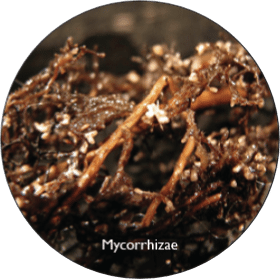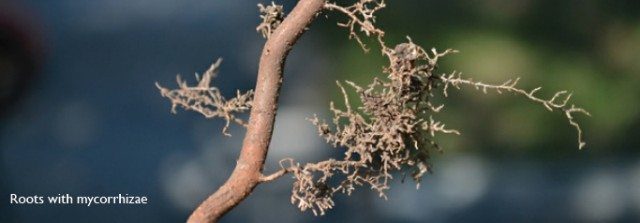This article was originally published in Garden Culture Magazine, Issue 1 under the title, “Fungi, Molasses & Rock Phosphate”.
Many plants go through a juvenile stage where they sharply increase in size before shifting their energy into flowering and fruiting. The size plants reach during this stage has an impact on how much harvest they produce.
Beneficial fungi, molasses, and rock phosphate have been used to help boost plant growth during this critical stage for years. They work in concert to help plants thrive. Since beneficial fungi take time to establish and colonize the root system, they are best introduced early. Mycorrhiza fungi are beneficial and assist in nutrient collection and uptake. Adding carbohydrates to a nutrient solution is a gardening trick for boosting plant performance going back to at least the 1960s.
 Mycorrhizae (fungus-roots) are found naturally occurring in healthy “live” soil. Sterile hydroponic media may require a spore inoculation to establish colonies. They are caused by mycorrhiza fungi infecting a plant root and the two together are what are known as mycorrhizae.
Mycorrhizae (fungus-roots) are found naturally occurring in healthy “live” soil. Sterile hydroponic media may require a spore inoculation to establish colonies. They are caused by mycorrhiza fungi infecting a plant root and the two together are what are known as mycorrhizae.
Plants with well-established mycorrhizae tend to perform better than those that do not. Approximately 90% of all plants can benefit from some form of mycorrhizae, including trees, shrubs, and garden plants. The relationship between mycorrhizae and the plant is a symbiotic one; both organisms benefit from their association with the other. The plant provides a carbohydrate source for the fungus, and in return, the fungus helps assist the plants in nutrient uptake, drought resistance, and blocking their environmental niche from pathogenic fungi. It is better to have helpful flat mates than destructive ones, so making sure beneficial fungi take up the space can prevent something worse from moving in. Mycorrhizae collect and process nitrogen, phosphorus and a variety of micronutrients and pass them to the plant. Of particular use is their ability to increase phosphorus uptake, which dramatically increases over non infected plants.
The two most important fungi for most gardeners are ecto-mycorrhizal, and endo-mycorrhizal. Ectomycorrhizae form primarily on tree and woody plant roots, although some can form on a wide variety of plants. The fungus forms a covering on the roots, and then branches out into the surrounding soil. Similar to hair extensions for roots, this fungal web called hyphae both extends the reach of the root system, and increases the amount of surface area collecting nutrients for the plant. This network of nutrient collecting hyphae is anchored between the cortex cells of the roots. The hyphae pick up nutrients from the soil, and transport them to the plant in exchange for carbohydrates made by the plant. Certain varieties also have antibiotic properties, which help protect the plant from infection, and the sheathing of fungus on the roots offers some protection from nematodes. Since the hyphae strands are thinner than roots, they not only extend the reach of the root system by meters, but they can also exploit smaller nooks and cracks in the growing media. One milliliter of colonized soil may contain up to four meters of ectomycorrhizae.
For most other green leafy plants including vegetables, endomycorrhizae is the more important fungus.
Instead of helping the plant by extending the root system, they improve the existing root system. Where ectomycorrhizae help by moving nutrients into the plant, endomycorrhizae help move nutrients within the roots themselves, speeding them to the rest of the plant for use. Weaving itself into the cortical cells of the roots, endomycorrhizae form small structures called arbuscules. These arbuscules are where the fungus delivers the transported nutrients for the plant to receive, and picks up carbohydrates supplied by the plant. Nutrients transported by endomycorrhizae include nitrogen, phosphorous, potassium, calcium, sulfur, and zinc, with an emphasis on phosphorous uptake. Of particular use is where rock phosphate is being used as a phosphorous source instead of the more available superphosphate, as endomycorrhizae speeds the solubility conversion. Adding endomycorrhizae generally replicates the effect of increasing the strength of phosphorous in nutrient solution by improving existing phosphorous uptake.

Although commonly already present in healthy soil, mycorrhizae fungus levels can be increased by adding powdered spores (inoculants) available at garden and hydroponic shops. Sterile media and poor soils can be brought from a complete absence of mycorrhizae to abundance with the use of inoculants. All they need is food (carbohydrates), water, and half a chance. High applications of chemical nutrients can be detrimental to development, so this system is less appropriate for “goose pate” style gardens where nutrient is supplied to the plant at the upper end of its ability to absorb. This can create an apparent paradox where continuing to apply additional nutrients can impede the plant’s nutrient absorption. For example, killing off the endomycorrhizae will require additional phosphorous to be added to make up for the loss in efficiency and uptake.
If using mycorrhizal inoculants, apply at the beginning of the season to establish the colonies early. Once established, the infected roots should serve as a host to allow the fungus to spread throughout the root system. Much like a small colony of mold will take over an entire loaf of bread; in a healthy root system mycorrhiza will spread to fill the available space. Plant improvements from inoculate use are particularly pronounced when used early in poor or sterile mediums. In soil that already contains high levels beneficial fungi, adding more spores has a less pronounced effect.
Mycorrhizae thrive on carbohydrates, which is part of what they receive in payment from the plant in exchange for helping the plant thrive. One way to boost beneficial microorganisms including mycorrhizae is to feed them with a carbohydrate additive such as molasses.
Carbohydrates (saccharides) are molecules with specific combinations of carbon and water. A subset of carbohydrates are the sugars ending in “-ose”. For example, table sugar is sucrose (C12H22O11), milk sugar is lactose (also C12H22O11, but the atoms are arranged differently), blood sugar is glucose(C6H12O6) and so on. Carbohydrates store energy that many life forms can use, people included. The “sugar rush” from eating a lot of sweets is an effect from overindulging in sugars. The energy is easily converted, but then is quickly used. Keep in mind that unwelcome visitors such as ants may be enticed to visit if a carbohydrate banquet available, so make sure to clean up any spills promptly.
The benefits of adding carbohydrates are mostly indirect; they don’t help the plants directly, they feed the beneficial microorganisms and mycorrhizae which help the plants. These microorganisms use the ready energy available in carbohydrates to thrive and reproduce. Cane syrup, maple syrup, fruit juice, and molasses can all be used as carbohydrate sources. Dilute to two teaspoons per gallon (10 ml./3.8 l.) of water. Cleanliness is a must, as these may attract insects and leave a sticky residue. Ants may be attracted to the residue, and if hydrated (mixed with water) and allowed to go anaerobic (stale) these may encourage the wrong sort of fungal growth.
Molasses (also known as Treacle) is a byproduct of sugar refining, and contains not only plenty of carbohydrates to add to your garden, but potassium, nitrogen, and iron as well. Many micronutrients are locked in their chelated form and require a chelating agent to unlock them. Molasses acts as a chelating agent (like Humic Acid), by energizing the root level biology, it makes micronutrients more readily available for nutrient uptake by the plants.
Be careful when purchasing molasses as prices vary widely. Although all three are usable for gardening purposes, molasses marketed as a plant additive tends to be very expensive, molasses intended for human consumption is moderately priced, and molasses sold as cattle feed supplement tends to be pretty cheap. Molasses sold for cattle feed is often mixed with a grain to add structure. The addition of grain not only makes the molasses easier to work with, but adds compostable organic material as an additional benefit. Personally, I tend to purchase molasses made for human consumption, as I don’t have a large garden; I like it on my pancakes, and in Shoo Fly Pie. Apply at two teaspoons (about 10ml.) per gallon of water, or the same amount per pancake.
To complete the trio, add a good dollop of powdered rock phosphate to the mix. Not only will this provide the mycorrhiza with a supply of phosphorous to supply the plant, but it can also provide a suitable environment for other beneficial organisms to take up residence. The well fed mycorrhiza should be put to work, and what they do best is absorb and supply phosphorous to the plant.
Rock phosphate is available in two forms, “soft rock” phosphate, and “hard rock” phosphate. Soft rock phosphate contains a higher amount of immediately available phosphorous, and is usually the choice for container soil enhancement. Hard rock phosphate is better suited to improve a field where plants are to be grown for several years, or where the soil is reused.
Mycorrhiza help bring phosphorous and other benefits to plants, and carbohydrates help mycorrhiza. During early growth is a good time to add inoculants with a packed carbohydrate lunch and rock phosphorous dessert to your growing media. Feeding your fungus carbohydrates regularly throughout flowering can have the end result of giving your plants a phosphorous boost, and reintroducing spores can help reestablish lost colonies.
Beneficial fungi help with keeping plants well fed, and proper nutrition is one of the keys to bountiful harvests. Embrace the fungus among us, feed them, and give them phosphorous to carry.
Recent studies seem to indicate that where plants or mycorrhizal fungi receive their needs from an external source their intercommunication system breaks down. Thus, although the fungal network grows, when you feed the soil directly, if it no longer is dependent on the plants carbs so it may not supply them with nutrients. Boston University is currently investigating this breakdown in plant- mycorrhizal interactions at the edge of forests. They also pondered whether trees in urban settings actually absorb carbon, or not, given the breakdown of the relationshi in urban settings. Thus carb rich soil may be less beneficial than leaf litter and compost for the plant – fungal relationship in the long run.
While it’s true that most any type of molasses can be used on plants, it needs to be unsulfured, as the sulfur is added to kill microorganisms, including fungi such as micorrhizae. Blackstrap is supposed to be the best molasses of all, due to mineral content.
Just fyi, phosphate in high amounts actually hurts endo-fungi and probably many other microbes. The small amount recommended here is not likely to harm the fungi, however. But a better “dessert” would include alfalfa meal and maybe some crab shell. Go nuts, but take it easy on the phosphate.
Adding molasses or other sugars will indeed help the mycorrhizal fungi to proliferate only now a scenario is created where sugars must constantly be added to maintain the mycorrhizal population. Much better to inoculate and allow the mycorrhizal fungi to grow naturally based on the photosynthetic sugars being provided by the plant or tree. Planting a diversity of trees and plants allows for a symphony of different mycorrhizal fungi in the soil and will create a harmonious symphony of life over time. Peace.